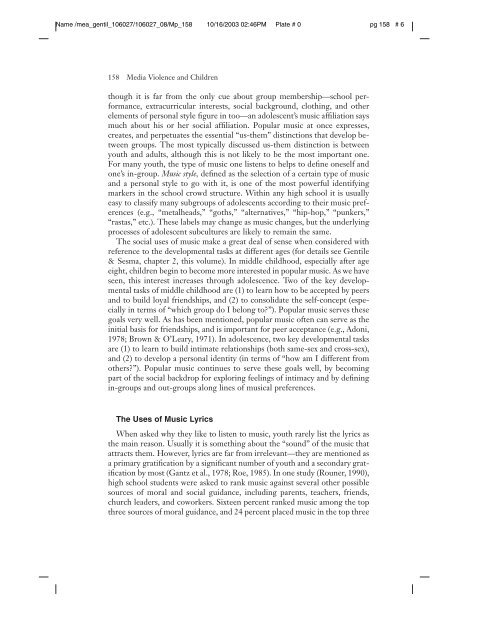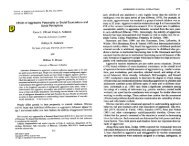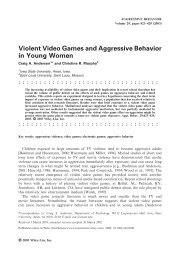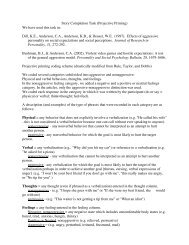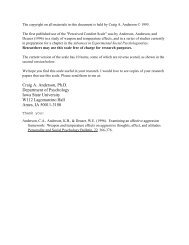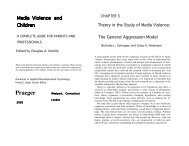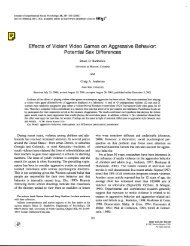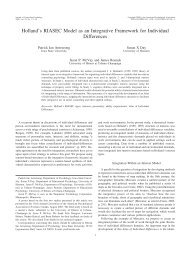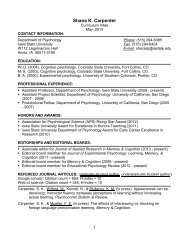The Effects of Violent Music on Children and Adolescents
The Effects of Violent Music on Children and Adolescents
The Effects of Violent Music on Children and Adolescents
You also want an ePaper? Increase the reach of your titles
YUMPU automatically turns print PDFs into web optimized ePapers that Google loves.
Name /mea_gentil_106027/106027_08/Mp_158 10/16/2003 02:46PM Plate # 0 pg 158 # 6<br />
158 Media Violence <strong>and</strong> <strong>Children</strong><br />
though it is far from the <strong>on</strong>ly cue about group membership—school performance,<br />
extracurricular interests, social background, clothing, <strong>and</strong> other<br />
elements <str<strong>on</strong>g>of</str<strong>on</strong>g> pers<strong>on</strong>al style figure in too—an adolescent’s music affiliati<strong>on</strong> says<br />
much about his or her social affiliati<strong>on</strong>. Popular music at <strong>on</strong>ce expresses,<br />
creates, <strong>and</strong> perpetuates the essential “us-them” distincti<strong>on</strong>s that develop between<br />
groups. <str<strong>on</strong>g>The</str<strong>on</strong>g> most typically discussed us-them distincti<strong>on</strong> is between<br />
youth <strong>and</strong> adults, although this is not likely to be the most important <strong>on</strong>e.<br />
For many youth, the type <str<strong>on</strong>g>of</str<strong>on</strong>g> music <strong>on</strong>e listens to helps to define <strong>on</strong>eself <strong>and</strong><br />
<strong>on</strong>e’s in-group. <str<strong>on</strong>g>Music</str<strong>on</strong>g> style, defined as the selecti<strong>on</strong> <str<strong>on</strong>g>of</str<strong>on</strong>g> a certain type <str<strong>on</strong>g>of</str<strong>on</strong>g> music<br />
<strong>and</strong> a pers<strong>on</strong>al style to go with it, is <strong>on</strong>e <str<strong>on</strong>g>of</str<strong>on</strong>g> the most powerful identifying<br />
markers in the school crowd structure. Within any high school it is usually<br />
easy to classify many subgroups <str<strong>on</strong>g>of</str<strong>on</strong>g> adolescents according to their music preferences<br />
(e.g., “metalheads,” “goths,” “alternatives,” “hip-hop,” “punkers,”<br />
“rastas,” etc.). <str<strong>on</strong>g>The</str<strong>on</strong>g>se labels may change as music changes, but the underlying<br />
processes <str<strong>on</strong>g>of</str<strong>on</strong>g> adolescent subcultures are likely to remain the same.<br />
<str<strong>on</strong>g>The</str<strong>on</strong>g> social uses <str<strong>on</strong>g>of</str<strong>on</strong>g> music make a great deal <str<strong>on</strong>g>of</str<strong>on</strong>g> sense when c<strong>on</strong>sidered with<br />
reference to the developmental tasks at different ages (for details see Gentile<br />
& Sesma, chapter 2, this volume). In middle childhood, especially after age<br />
eight, children begin to become more interested in popular music. As we have<br />
seen, this interest increases through adolescence. Two <str<strong>on</strong>g>of</str<strong>on</strong>g> the key developmental<br />
tasks <str<strong>on</strong>g>of</str<strong>on</strong>g> middle childhood are (1) to learn how to be accepted by peers<br />
<strong>and</strong> to build loyal friendships, <strong>and</strong> (2) to c<strong>on</strong>solidate the self-c<strong>on</strong>cept (especially<br />
in terms <str<strong>on</strong>g>of</str<strong>on</strong>g> “which group do I bel<strong>on</strong>g to?”). Popular music serves these<br />
goals very well. As has been menti<strong>on</strong>ed, popular music <str<strong>on</strong>g>of</str<strong>on</strong>g>ten can serve as the<br />
initial basis for friendships, <strong>and</strong> is important for peer acceptance (e.g., Ad<strong>on</strong>i,<br />
1978; Brown & O’Leary, 1971). In adolescence, two key developmental tasks<br />
are (1) to learn to build intimate relati<strong>on</strong>ships (both same-sex <strong>and</strong> cross-sex),<br />
<strong>and</strong> (2) to develop a pers<strong>on</strong>al identity (in terms <str<strong>on</strong>g>of</str<strong>on</strong>g> “how am I different from<br />
others?”). Popular music c<strong>on</strong>tinues to serve these goals well, by becoming<br />
part <str<strong>on</strong>g>of</str<strong>on</strong>g> the social backdrop for exploring feelings <str<strong>on</strong>g>of</str<strong>on</strong>g> intimacy <strong>and</strong> by defining<br />
in-groups <strong>and</strong> out-groups al<strong>on</strong>g lines <str<strong>on</strong>g>of</str<strong>on</strong>g> musical preferences.<br />
<str<strong>on</strong>g>The</str<strong>on</strong>g> Uses <str<strong>on</strong>g>of</str<strong>on</strong>g> <str<strong>on</strong>g>Music</str<strong>on</strong>g> Lyrics<br />
When asked why they like to listen to music, youth rarely list the lyrics as<br />
the main reas<strong>on</strong>. Usually it is something about the “sound” <str<strong>on</strong>g>of</str<strong>on</strong>g> the music that<br />
attracts them. However, lyrics are far from irrelevant—they are menti<strong>on</strong>ed as<br />
a primary gratificati<strong>on</strong> by a significant number <str<strong>on</strong>g>of</str<strong>on</strong>g> youth <strong>and</strong> a sec<strong>on</strong>dary gratificati<strong>on</strong><br />
by most (Gantz et al., 1978; Roe, 1985). In <strong>on</strong>e study (Rouner, 1990),<br />
high school students were asked to rank music against several other possible<br />
sources <str<strong>on</strong>g>of</str<strong>on</strong>g> moral <strong>and</strong> social guidance, including parents, teachers, friends,<br />
church leaders, <strong>and</strong> coworkers. Sixteen percent ranked music am<strong>on</strong>g the top<br />
three sources <str<strong>on</strong>g>of</str<strong>on</strong>g> moral guidance, <strong>and</strong> 24 percent placed music in the top three


